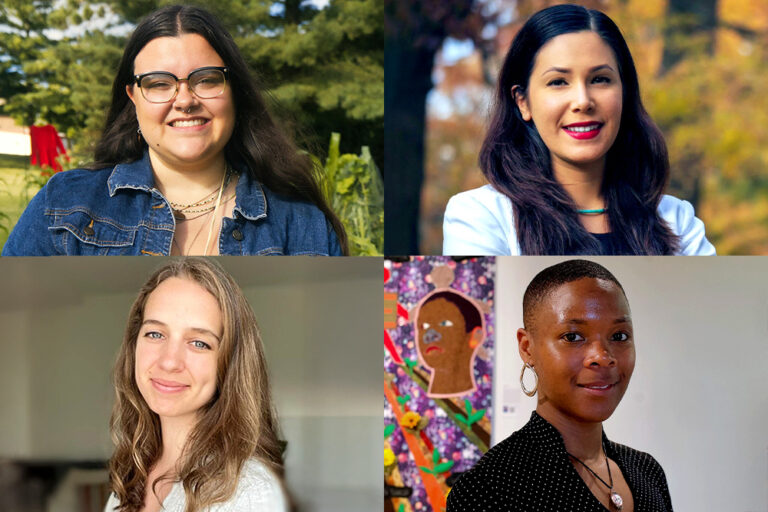A joint, multidisciplinary project between Michigan State University and The Ohio State University that examines sounds of religion throughout the United States, and which first began in 2015, recently received a three-year, $750,000 grant from the Henry Luce Foundation to support expansion of the project. The grant was approved in conjunction with a request for proposals issued by the Luce Foundation’s Theology Program.
The American Religious Sounds Project (ARSP) is a multiyear, collaborative initiative led by Amy DeRogatis, Professor of Religion and American Culture in the Department of Religious Studies at Michigan State University, and Isaac Weiner, Associate Professor of Comparative Studies and Associate Director of the Center for the Study of Religion at The Ohio State University.
With the aim of generating innovative scholarship, the ARSP challenges scholars and others to consider how they might understand American religious diversity in new and complex ways by listening to its sounds.

“The need for understanding religious pluralism has arguably never been greater. Given the remarkable diversity of American religious life and the increasing polarization of our politics, building a civic culture that is inclusive and valuing of all peoples constitutes one of the most pressing challenges we face today,” DeRogatis said. “The ARSP aims to bring together, educate, and engage multiple constituencies around issues of religious diversity in ways that are accessible, compelling, and intellectually rigorous.”
The ARSP originated as the “Religious Soundmap Project of the Global Midwest” with support provided by the Humanities Without Walls consortium in 2015. A year later, the project received a two-year, $200,000 grant from the Henry Luce Foundation.
During these initial phases of the project, a digital audio archive was created, which consists of hundreds of recordings of formal and informal sounds of religious institutions, including prayer, chanting, and hymns. For these recordings, the research team cast its net widely and visited churches, synagogues, mosques, temples, homes, workplaces, interfaith chapels, coffee houses, race tracks, public parks, political rallies, arts festivals, and even college football games.
The ARSP aims to bring together, educate, and engage multiple constituencies around issues of religious diversity in ways that are accessible, compelling, and intellectually rigorous.
Dr. Amy DeRogatis
This growing audio archive documents the practices of a wide range of religious communities, including Christian and non-Christian traditions, across a broad selection of sites.
To make these recordings accessible to the public, a website is being developed and will launch later this fall that will invite users to explore the ARSP audio archive, discover connections among recordings, plot them on a map according to the geographical location where they were produced, and listen to short, edited clips. The website also will include a digital gallery with multimedia exhibits on selected themes, sounds, and communities, featuring images, explanatory texts, and interpretive audio collages and essays.
“The targeted audience for the American Religious Sounds Project moves beyond scholars of American religion. We hope that our platform provides a curated space for the exchange of ideas about religion, space, sound, and time across disciplines and communities,” Weiner said. “By creating an innovative and interactive platform, we aim to encourage further collaboration among potential users and inspire new approaches to religion and sound through engagement with our digitized materials.”

The latest Luce Foundation grant will support the next phase of the project, which will focus on four areas of development and expansion:
- Geographic Expansion
Up to this point, the ARSP has focused on local communities in central Michigan and central Ohio. The ARSP will now work to expand the geographic scope of its audio archive by reaching out to community partners and scholars at other academic institutions to contribute to the archive.
- Interpretive Scholarship
The ARSP will offer mini-grants to support innovative scholarship and community engagement projects on sound and American religions. In addition, the ARSP website will offer a forum to provide scholars with the opportunity to share emerging work about sound and through sound.
- Digital and Archive Development
At present, the ARSP website features only short, edited clips, produced from longer recordings. The digital and archive development team will work to make the full ARSP archive publicly accessible to allow for exploration of the archive alongside curated multimedia gallery exhibits. The team also will transfer the audio archive from The Ohio State University to Michigan State University.
- Community Engagement
Committed to advancing the public understanding of religion through community engagement and public outreach, the ARSP will sponsor training workshops, provide recording equipment, and offer technical support, so religious communities can document their own practices and traditions and for others to tell their own stories about religion and sound. The research team also plans to partner with museums to create a traveling exhibition using sound as a way of teaching about religious diversity within the United States.
“We have set ambitious goals for this three-year grant,” DeRogatis said. “By promoting new scholarly research, building new digital platforms, and fostering new forms of collaboration, this field-shaping initiative stands ready to advance the public understanding of religion in the United States.”
The ARSP research team includes both undergraduate and graduate student researchers. DeRogatis and Weiner also have incorporated the project into their classrooms. Last spring, they published an article in the journal Religion, titled Turning students into scholars: using digital methods to teach the critical study of religion, where they discuss two courses they taught in conjunction with the Religious Soundmap Project of the Global Midwest.
By promoting new scholarly research, building new digital platforms, and fostering new forms of collaboration, this field-shaping initiative stands ready to advance the public understanding of religion in the United States.
Dr. Amy DeRogatis
At the end of the three-year grant cycle, or in spring 2021, a conference will be held to bring all participants together to present their research, network with future collaborators, and share ideas for the future of the American Religious Sounds Project. In addition, the ARSP’s leadership structure will be reorganized to strengthen its collaboration with other institutions and to ensure the project’s long-term growth and sustainability.
DeRogatis and Weiner have presented the ARSP at national and international academic conferences including the 2018 Digital Humanities Conference in Mexico City. And earlier this month, they discussed their approach to sound and religion during the opening event at the Art Institute of Chicago for the art exhibit “Prayer” by South African sound artist James Webb.
For more information or to follow the progress of the American Religious Sounds Project, please see the ARSP blog.


